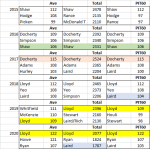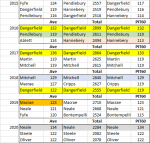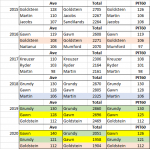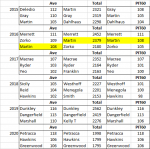Hey Rowsus, it’s been a while since I’ve posted but I’ve had this question on my mind for a while.
I see a lot of people comment that you almost have to start the most expensive players because “even if they drop, you’ll need to use at least 2 trades to bring them in”.
What are your thoughts on this idea that it’s a much worse thing to use 2 downgrade trades to bring in 1 star (2 down, 1 up), vs the typical aim of 1 downgrade per premium added (1 down, 1 up)?
For me the math makes little sense, as it’s assumed that if I’ve not started one of these 2 trade players (like Max Gawn) that I’ve used the money to either get multiple premium/keepers, or a mid priced type (like Pruess) who, if things go well, should only require 1 down, 1 up. The other part of the math that doesn’t make sense to me is prices. I’ve seen people say it’s ok if the players average drops by, say, 10 points, because of the whole two trades thing. With a player that expensive, you’re effectively locking in a $100kish loss with that mindset, in a game where you are trying to maximise total squad value and points.
The only reason, in my mind, to start a player that is so expensive and could drop, is captain scores. For me, you pick your two captains and all rookies before building the rest of your side, so it’s ok if the reason is captain, but not ok if the reason is somehow saving trades. Am I missing something though as I’d prefer to be wrong in this forum than in my SC team.
Cheers and I hope you are well.
I see a lot of people comment that you almost have to start the most expensive players because “even if they drop, you’ll need to use at least 2 trades to bring them in”.
What are your thoughts on this idea that it’s a much worse thing to use 2 downgrade trades to bring in 1 star (2 down, 1 up), vs the typical aim of 1 downgrade per premium added (1 down, 1 up)?
For me the math makes little sense, as it’s assumed that if I’ve not started one of these 2 trade players (like Max Gawn) that I’ve used the money to either get multiple premium/keepers, or a mid priced type (like Pruess) who, if things go well, should only require 1 down, 1 up. The other part of the math that doesn’t make sense to me is prices. I’ve seen people say it’s ok if the players average drops by, say, 10 points, because of the whole two trades thing. With a player that expensive, you’re effectively locking in a $100kish loss with that mindset, in a game where you are trying to maximise total squad value and points.
The only reason, in my mind, to start a player that is so expensive and could drop, is captain scores. For me, you pick your two captains and all rookies before building the rest of your side, so it’s ok if the reason is captain, but not ok if the reason is somehow saving trades. Am I missing something though as I’d prefer to be wrong in this forum than in my SC team.
Cheers and I hope you are well.
Essentially it comes down to a finite amount of trades and cash generation during the season combined with a finite amount of "keepers" at any position.
Yes, in theory you can win this game on pure value, every year someone works out the zero trade team that would win it but the reality is that every value pick has inherent risks that have created that value, be it injury, role changes, breakout, whatever, and those risk compound with every value pick you select.
Take your Preuss example, you've simplified it down to 1 down, 1 up but what you've really done here is left 180k in the bank at the start, paying more for a cash cow gives the impression you've "saved" a trade but you could achieve the same thing by picking a 120k rookie who averages 60 and just keeping the money in the bank until the trade.
Ultimately your starting picks are one of two things. They're a cash cow or they're a keeper, every keeper is an up/down you can use elsewhere, there is inherent value in this.
Now, obviously, if you can get a keeper for value, that's a slam dunk and you should take it every time over paying a premium. That's why every man and his dog is starting Cripps.
But the reality is we only have so many trades and come round 15 or so when everyone is approaching their finished side and you've used the best part of your 24 trades you need as many of those keepers to be the top level guys. The more of the elite picks you start with, the more value scope you have. Someone who starts with a midfield full of 105-110 types needs to fill it with the 115+ guys, of which there are considerably fewer. Someone who starts with the 115+ guys can fill with the horde of 105-110 guys. Having to pick from the 3 120 guys that are 680k is very different than being able to find the 110 guys who've fallen to 520k.
I also don't think most of us that are picking top guys are doing it expecting to lose value. Those top end guys I'm picking are the ones I expect to hold their average and have a narrative that says they can improve (to me). You're also paying for durability or should be in that range. I'm picking Neale because I legitimately think he can back it up or improve, now I don't think he will but I think he can and I think if he doesn't he should still approach the 125 range that would remain a prohibitive upgrade, he's also a captain option.
The rucks are probably their own set of rules here but with Marshall it's actually not as relevant this year because you can start him in the rucks as a forward premium and still pick the rookies elsewhere or you can back Preuss in to match the rookies (he very well may). Still, I'm personally taking Gawn, I don't think he can improve but I actually think he can go a lot closer to maintaining than probably most, I don't think 135 is impossible for him, his DT improvement last year was actually greater than his SC increase which kind of undermines the broken SC theory, in fact his SC increase was lower than you'd expect given his historical ratios (you'd actually have expected 142 based on those), also a strong captain obviously.
I do agree fundamentally you shouldn't be picking a player to drop, break even I can understand given the other things you'd also be picking them for (durability, captain, exposure, etc), you should be picking those top tier guys you think can sustain or possibly improve BUT if they do drop would still be premiums.
For example, I like Steele, I think he can improve, I think he can sustain and if he did drop I think it would be into the 115 range where he'd still be a premium keeper, I think that's still a fine outcome and enough "value" as a starting pick. I don't like Macrae (devils advocate mode), I don't think Treloar is a good change for him, I don't like his 98 average when they were full strength to close last year and I don't like his downward trend, I think 123 is his best case but he's likely to drop to 110 or below (devils advocate reminder), I don't think this example makes sense as a starting pick because there is no value, if I'm right about his top end my worst case is paying the same for him and if I'm totally right I can get him a lot cheaper.
Finally, locking in the loss part, hopefully most of the above has outlined that you're not trying to do that and should probably rethink the pick if you are, but if it happens the idea is that you've still got a premium and you've still got the trades you haven't had to use on that starting pick. I don't think you should be picking a player you expect to lose 100k outside of very rare circumstances, it's more a this is how much can go wrong and the pick has still achieved it's ends, being a keeper.
Ultimately... maximise value, minimise risks. Picking well balanced keepers is walking down the middle of this line, you should still see value in the pick but knowing that the downside risk is still a likely keeper has it's value.











